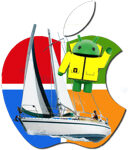 The Department of Ecology, Sustainable Development and Energy, published on 4 August a Boating Safety Alert about LEDs bulbs (¹). The text warns boaters on the risks of radio interference found where the VHF antennas are close to navigation lights or bridge lamps equipped with LEDs bulbs.
The Department of Ecology, Sustainable Development and Energy, published on 4 August a Boating Safety Alert about LEDs bulbs (¹). The text warns boaters on the risks of radio interference found where the VHF antennas are close to navigation lights or bridge lamps equipped with LEDs bulbs.
Indeed, some LEDs (Light-Emitting Diode) can cause electromagnetic interference disrupting high-frequency radio emissions such as VHF, causing losses in the transmission of AIS data, and also that of the GPS data by VHF transmitters with Digital Selective Call in the event of a distress signal. These interferences are generally due to bad bulbs power supply and shield design
Electromagnetic interference, or NDE (Electro Magnetic Interference), is largely due to the fact that the power supply of the LEDs regulates the battery voltage (10V to 14V) via a DC/DC converter. This energy conversion is done through a high frequency "cutout" characterized by a high efficiency but which can generate electromagnetic interference on the frequency used by our VHF and AIS transmitters
The result is a circuit with lots of inductance that produces an electric field around the circuit. In most cases, The body of the lamp is made of plastic, which does not block the emission of the field. Accordingly, The field may interfere with the electrical devices around it. In a good design of the power supply, current drivers are individually shielded to constrain the field, and the power supply itself must be electrically isolated by metal shielding.
As a rule, The CE marking is mandatory on the LEDs. It assumes the electrical and photobiological safety of the lamps, as well as their electromagnetic compatibility (EMC ²). Bulbs marked CE-2014/30/EU should not present risk of electromagnetic interference. However the EC standard requires that a declaration of conformity on the honour on the part of the manufacturer or the importer who remain solely responsible for the drafting of technical documentation and control procedures (³).
[Update] We can also trust the French standard NF EN-60945 (2003 Amended 2008) or even IEC 60945 (2002, Amended 2008). The choice is yours !
It is therefore up to boaters to check compliance with one of these standards on the lamps purchased, and return to distributors those would not be compliant with.
–––
(¹) Jamming of the VHF Marine band by LED lighting : Navigation lights, Projectors and various lighting (²) Directive 2014/30/EU of 26 February 2014
(³) In the United States, any piece of electrical equipment sold there must be submitted to the Federal Communications Commission (FCC) CFR47 which tests and verify conformity.
–––


Francis,
For having worked on sensitive military marshals EMI RFI, Olivier Bouyssou's summary.
EMI disturbances are due to fast switching from slicing to harmonics 156 Mhz in the Fourrier decomposition (this is the frequency of the VHF safety channel) However, the LEDs consume 10 times less than non-native bulbs, we save nearly 100AH over 24 hours if they are turned on, The equivalent of the fridge so much more for him and the fresh water for the pastis.
Et on fait comment pour vérifier le respect de la norme CE 2014/30/UE sur les lampes achetées ?
Sur la doc du fabricant, et ensuite à l’usage 😉